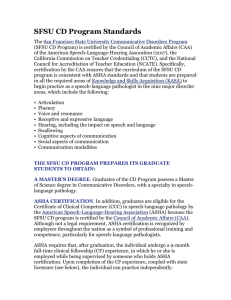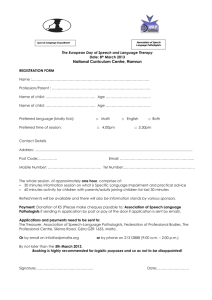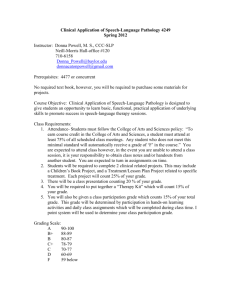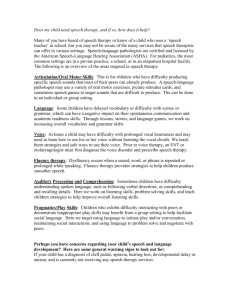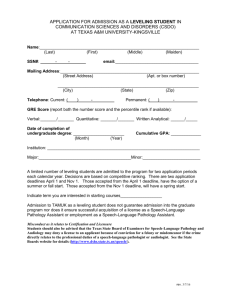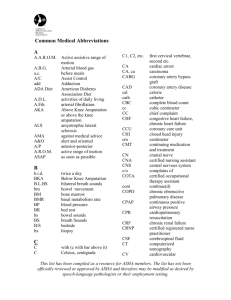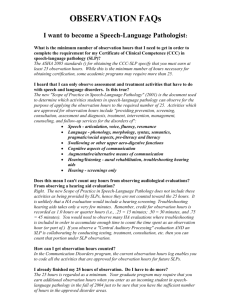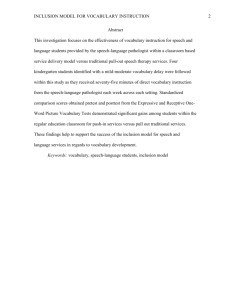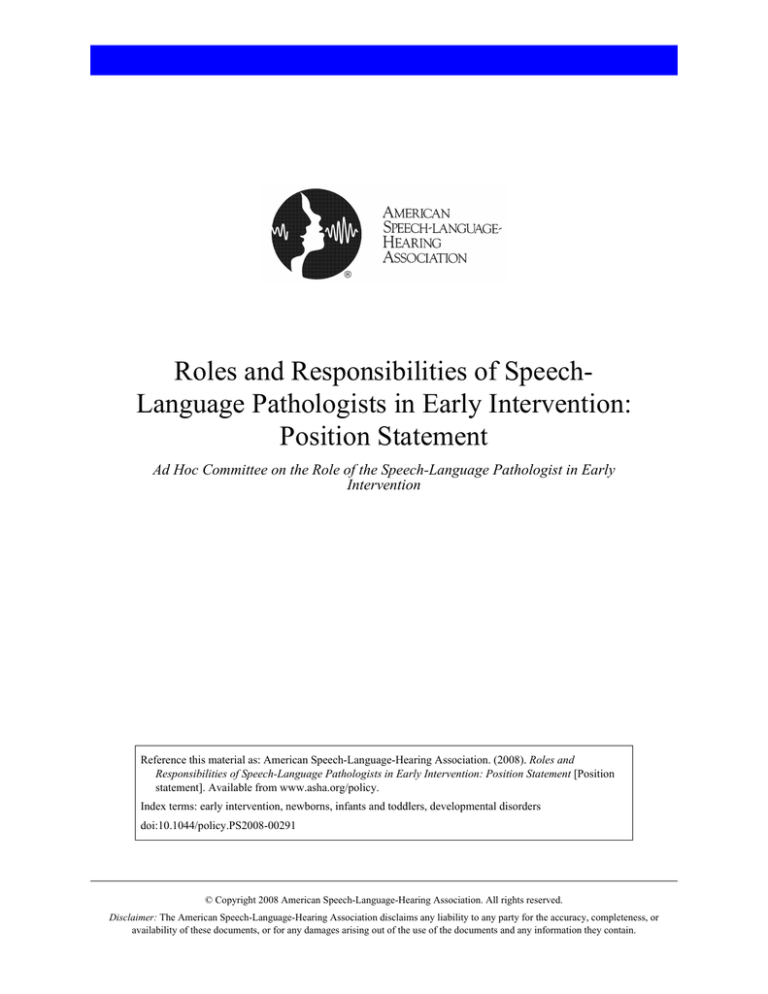
Roles and Responsibilities of SpeechLanguage Pathologists in Early Intervention:
Position Statement
Ad Hoc Committee on the Role of the Speech-Language Pathologist in Early
Intervention
Reference this material as: American Speech-Language-Hearing Association. (2008). Roles and
Responsibilities of Speech-Language Pathologists in Early Intervention: Position Statement [Position
statement]. Available from www.asha.org/policy.
Index terms: early intervention, newborns, infants and toddlers, developmental disorders
doi:10.1044/policy.PS2008-00291
© Copyright 2008 American Speech-Language-Hearing Association. All rights reserved.
Disclaimer: The American Speech-Language-Hearing Association disclaims any liability to any party for the accuracy, completeness, or
availability of these documents, or for any damages arising out of the use of the documents and any information they contain.
Roles and Responsibilities of Speech-Language Pathologists in
Early Intervention: Position Statement
About This
Document
Position statement
This position statement is an official statement of the American Speech-LanguageHearing Association (ASHA). It was developed by ASHA's Ad Hoc Committee
on the Role of the Speech-Language Pathologist in Early Intervention. Members
of the Committee were M. Jeanne Wilcox (chair), Melissa A. Cheslock, Elizabeth
R. Crais, Trudi Norman-Murch, Rhea Paul, Froma P. Roth, Juliann J. Woods, and
Diane R. Paul (ex officio). ASHA Vice Presidents for Professional Practices in
Speech-Language Pathology Celia Hooper (2003–2005) and Brian B. Shulman
(2006–2008) served as the monitoring officers. The ASHA Scope of Practice in
Speech-Language Pathology (ASHA, 2007) states that the practice of speechlanguage pathology includes providing services for infants and toddlers with
communication needs. The ASHA Preferred Practice Patterns for the Profession
of Speech-Language Pathology (ASHA, 2004) are statements that define
universally applicable characteristics of practice. It is required that individuals who
practice independently in this area hold the Certificate of Clinical Competence in
Speech-Language Pathology and abide by the ASHA Code of Ethics (ASHA,
2003), including Principle of Ethics II, Rule B, which states that “individuals shall
engage in only those aspects of the profession that are within their competence,
considering their level of education, training, and experience.” This document was
approved by the ASHA Board of Directors (BOD 4-2008) in February 2008. This
position statement replaces the 1990 ASHA document The Roles of SpeechLanguage Pathologists in Service Delivery to Infants, Toddlers, and Their
Families.
****
Position Statement
It is the position of the American Speech-Language-Hearing Association (ASHA)
that speech-language pathologists have a central role in providing services and
supports for families and their infants or toddlers with disabilities as members of
the early intervention team. Furthermore, the appropriately certified and licensed
(as applicable) speech-language pathologist is qualified to address delays and
disabilities in communication, language, speech, emergent literacy, and feeding/
swallowing. Effective communication is fundamental to all aspects of human
functioning, particularly learning and social interaction. The development of
communication skills begins at birth. Families with infants and toddlers (birth–36
months) who are at risk for or have disabilities should receive developmentally
supportive care that addresses a broad spectrum of priorities and concerns
(Individuals with Disabilities Education Improvement Act, 2004; National
Association for the Education of Young Children, 2005; National Research
Council & Institute of Medicine, 2000; Sandall, Hemmeter, Smith, & McLean,
2005).
Speech-language pathologists, as autonomous professionals, assume various roles
in addressing the concerns and priorities of families and their infants or toddlers,
and should be included on any early intervention team for children who are at risk
for or have communication, language, speech, emergent literacy, or feeding/
swallowing impairments. These roles are implemented in collaboration with
families, caregivers, and other professionals, and include but are not limited to (a)
prevention; (b) screening, evaluation, and assessment; (c) planning, implementing,
and monitoring intervention; (d) consultation with and education for team
members, including families and other professionals; (e) service coordination; (f)
1
Roles and Responsibilities of Speech-Language Pathologists in
Early Intervention: Position Statement
Position statement
transition planning; (g) advocacy; and (h) awareness and advancement of the
knowledge base in early intervention. These roles should be implemented in accord
with the following guiding principles:
1. Services are family centered and culturally and linguistically responsive.
2. Services are developmentally supportive and promote children's participation
in their natural environments.
3. Services are comprehensive, coordinated, and team based.
4. Services are based on the highest quality evidence that is available.
Extensive information and references about these guiding principles and roles and
responsibilities of speech-language pathologists in early intervention can be found
in the companion ASHA technical report, guidelines, and knowledge and skills
documents (ASHA, 2008a, 2008b, 2008c).
References
American Speech-Language-Hearing Association. (2003). Code of ethics. Available from
www.asha.org/policy.
American Speech-Language-Hearing Association. (2004). Preferred practice patterns for
the profession of speech-language pathology. Available from www.asha.org/policy.
American Speech-Language-Hearing Association. (2007). Scope of practice in speechlanguage pathology. Available from www.asha.org/policy.
American Speech-Language-Hearing Association. (2008a). Core knowledge and skills in
early intervention speech-language pathology practice. Available from www.asha.org/
policy.
American Speech-Language-Hearing Association. (2008b). Roles and responsibilities of
speech-language pathologists in early intervention: Guidelines. Available from
www.asha.org/policy.
American Speech-Language-Hearing Association. (2008c). Roles and responsibilities of
speech-language pathologists in early intervention: Technical report. Available from
www.asha.org/policy.
Individuals with Disabilities Education Improvement Act of 2004, 20 U.S.C. § 1400 et seq.
National Association for the Education of Young Children. (2005). Screening and
assessment of young English-language learners. Supplement to the NAEYC position
statement on early childhood curriculum, assessment, and program evaluation.
Washington, DC: Author.
National Research Council & Institute of Medicine. (2000). Shonkoff, J. P., & Phillips, D.
A. (Eds.). From neurons to neighborhoods: The science of early childhood
development. Washington, DC: National Academy Press.
Sandall, S., Hemmeter, M. L., Smith, B. J., & McLean, M. E. (2005). DEC recommended
practices: A comprehensive guide for practical application in early intervention/early
childhood special education. Longmont, CO: Sopris West.
2


